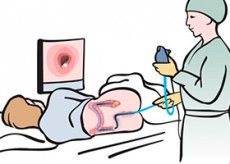Polyps of the rectum
Last reviewed: 23.04.2024

All iLive content is medically reviewed or fact checked to ensure as much factual accuracy as possible.
We have strict sourcing guidelines and only link to reputable media sites, academic research institutions and, whenever possible, medically peer reviewed studies. Note that the numbers in parentheses ([1], [2], etc.) are clickable links to these studies.
If you feel that any of our content is inaccurate, out-of-date, or otherwise questionable, please select it and press Ctrl + Enter.

Polyps of the rectum are benign epithelial tumors. They account for approximately 92% of all benign intestinal formations.
According to the clinical classification, polyps are divided into single, multiple (group and scattered in different departments) and diffuse polyposis of the large intestine. Polypozis is characterized by massive lesions, can be transmitted by inheritance, i.e., is a genetically determined disease, and in its description the term "diffuse family polyposis" is used.
The sizes of single and group polyps vary from millet grain to walnut size. Polyps may have a leg, sometimes reaching 1.5-2 cm, or be located on a wide base. With diffuse polyposis, they thickly cover the entire mucosa of the rectum and large intestine. According to its histological structure, the polyps are divided into adenomatous, villous and mixed (adenomatous-villous).
 [1]
[1]
Symptoms of polyps of the rectum
In most cases, polyps of the rectum are asymptomatic and are an occasional finding in endoscopy performed for any other disease or for the purpose of preventive examination of the large intestine. However, as the size of the polyps increases, ulceration of their surface may appear, and then progress, such clinical symptoms of polyps of the rectum, as pulling pain in the lower abdomen or lumbosacral region, pathological discharge from the rectum. For large villous tumors, metabolic disturbances (changes in the water-electrolyte balance, a significant loss of protein) are characteristic. Anemia can occur.
Diagnosis of rectum polyps
At the time of the appearance of the clinical symptomatology described above, all methods of proctological examination are used, from finger research to colonoscopy. The detection of polyps at an earlier (asymptomatic) stage is possible with preventive examinations of persons over 40 years of age, which, according to V.D. Fedorov and Yu. V. Dultseva (1984), will allow to diagnose about 50% of all benign tumors. Since 50 to 70% of tumors are located in the left part of the colon, then for prophylactic examination can serve as a sigmoidoscopy. At the same time, the detection of polyps in the rectum and distal part of the sigmoid is a direct indication for a colonoscopy in order to avoid the multiple nature of the lesion.
Adenomatous (glandular) polyps are found most often. They are rounded formations on the pedicle or broad base, rarely bleed and ulcerate.
Adenomatous-villous (adenopapillomatous, or ferruginous) polyps are usually more adenomatous and exceed 1 cm in diameter. With endoscopy, these polyps are seen as multi-lobed formations. In fact, their multi-lobed form is due to the unevenness of the surface, which can ulcerate, become covered with fibrinous overlays and bleed.
The nasal tumors can reach large sizes. With endoscopy, they are defined either in the form of a polypoid formation on a long, thick stalk, or in the form of a formation that extends over the intestinal wall over a considerable length. The nasal tumors have a different color of the surface (from whitish to bright red), ulcerate, bleed and often malignant.
What do need to examine?
How to examine?
Treatment of polyps of the rectum
Conservative treatment of polyps of the rectum with the juice of celandine was proposed in 1965 by AM Aminev. However, it was not widely used because of insufficient efficiency. Specialists dealing with this problem speak out against the use of celandine for the treatment of polyps, since the attempt of conservative treatment of polyps leads to the postponement of surgical treatment.
The most common methods of surgical treatment of polyps of the rectum are:
- polypectomy through an endoscope with electrocoagulation of the pedicle or polyp base;
- transanal excision of the neoplasm;
- removal of the tumor by colotomy or gut resection by the peritoneal method.
Considering the possibility of recurrence and malignancy of polyps, a system of clinical examination of patients after surgical treatment was developed. It includes endoscopic control of the condition of the rectum and large intestine, especially in the most dangerous period - the first 2 years after the operation. During these years, the interval between endoscopic examinations does not exceed 6 months, and in patients after removal of villous tumors most prone to recurrence and malignization in early periods, this interval does not exceed 3 months.
In case of relapse, repeated surgical treatment of rectal polyps is recommended, followed by systematic endoscopic control. In cases where the results of a histological examination of the removed polyp indicate malignancy of the process, but there is no malignancy at the base or leg of the polyp, the first endoscopic control study with multiple biopsies is performed 1 month after the operation. With a favorable result of a biopsy, patients continue to be examined every 3 months, and later - 2 times a year. If invasive growth extends to the foot of the polyp or its base, a radical oncological operation is indicated.

